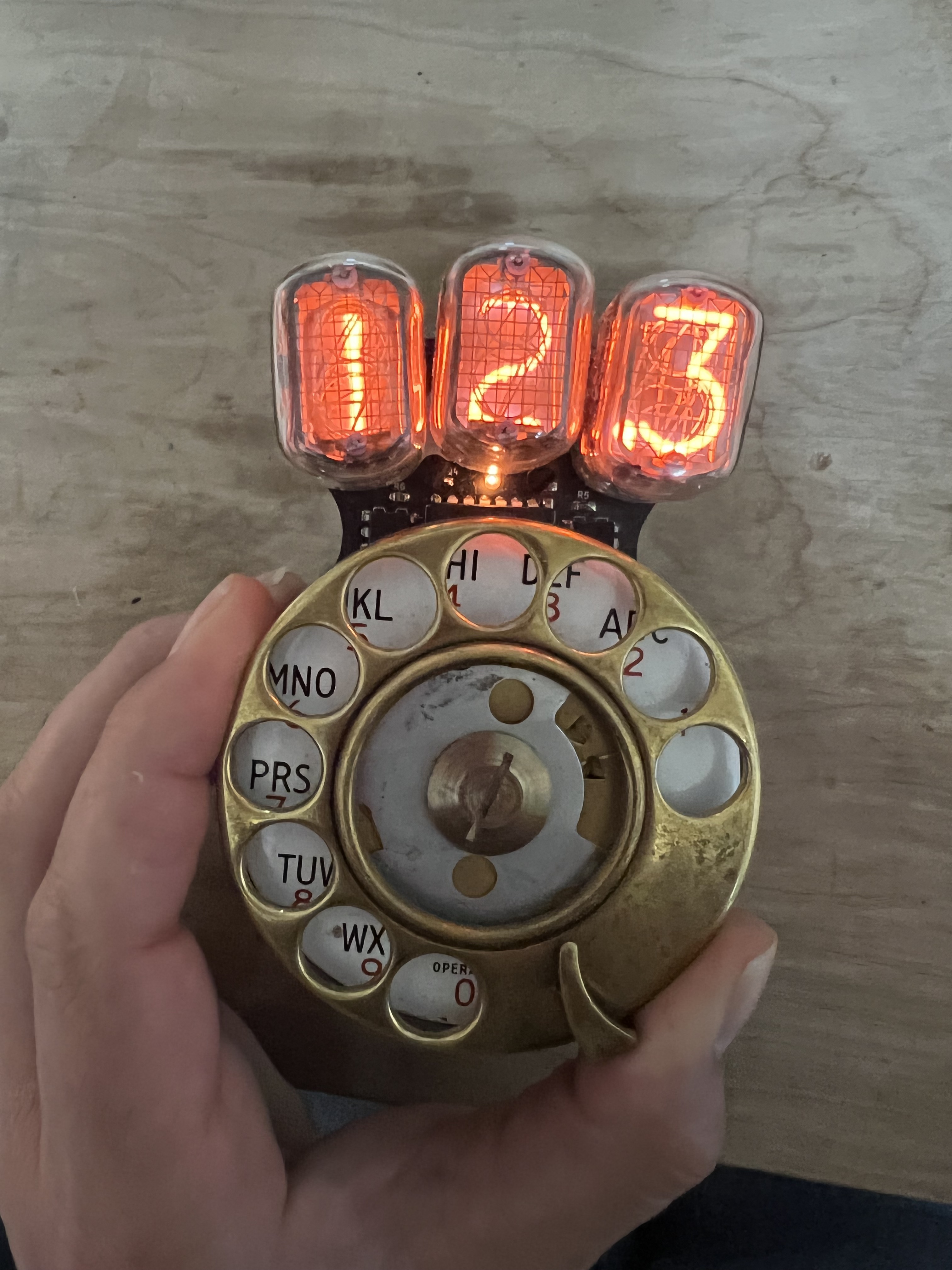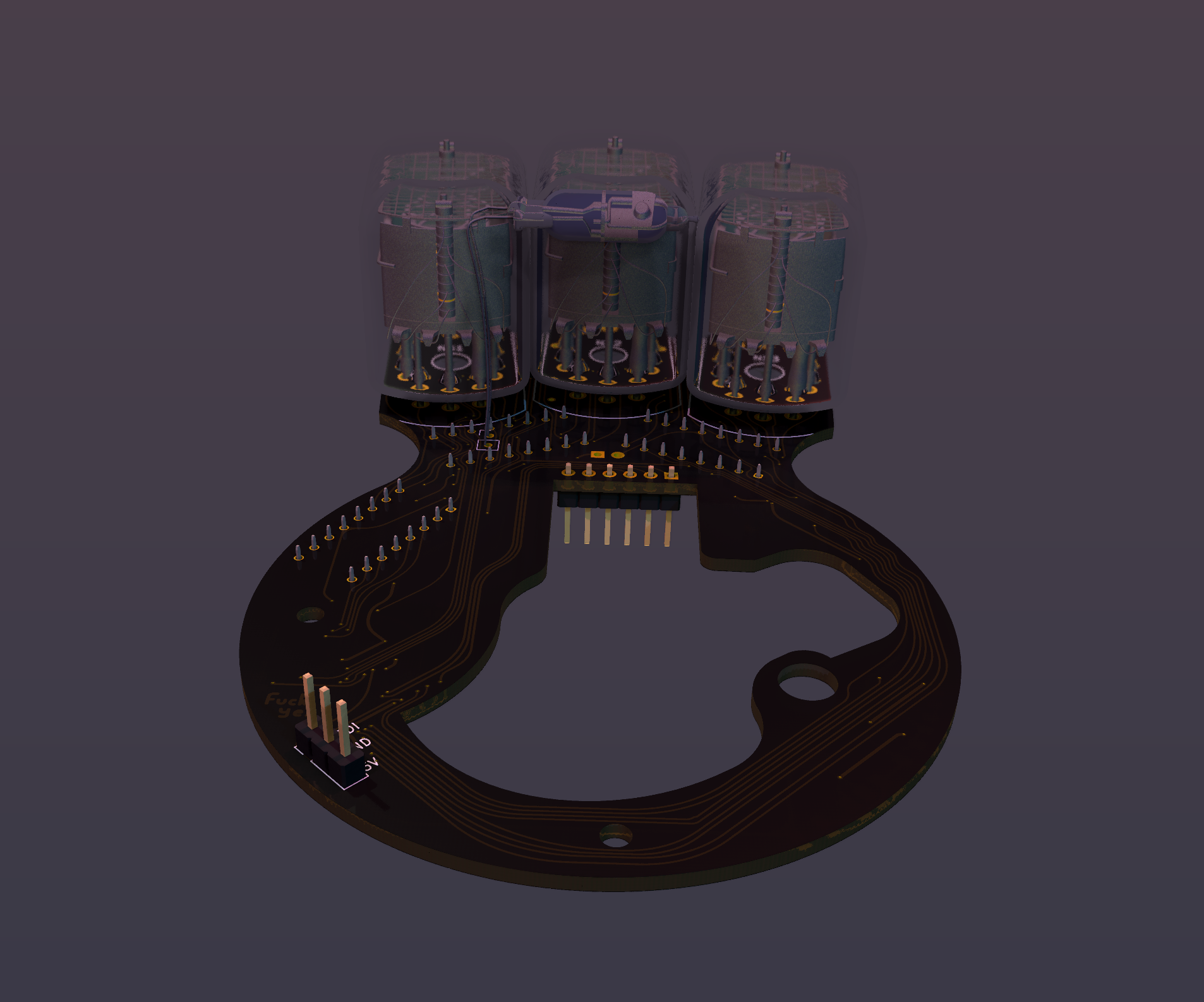-
This is the old description for posterity
08/17/2022 at 17:13 • 0 commentsRotaDuck
Sticking Nixie tubes to an old rotary telephone dial
This is the old project description, I changed enough stuff that I might as well just rewrite it and copy the old one here.
Here's a video of it in action
And there's a few more on my Youtube Channel
I'll do a more complete write-up at some point in the future, but for now I'll mention a few things.
![]()
It stores the running count (and a history of recent entries) in EEPROM because when the dial returns to it's resting position, the power is completely cut off. That makes it so I couldn't just use timing to figure out when the pulses stop (and the number that was ultimately dialed) so instead I put in a resistor ladder so the between the 3 contacts on the dial to give me 1/2 voltage on the last number, when the dial is between 0 and the end. that gives me a waveform like this:
_ _ _ _
__| |_| |_| |_| |_,-,___
So it does all the saving during that shorter last pulse, which is pretty tight because EEPROM access is relatively slow.
![]()
I didn't want to add any buttons to it so instead it uses multiple 9s and 0s for special codes, here's the list of what they do 0 - subtract the next number dialed from the total 000 - clear all counts to 0
9 - show total for all days 99 - list each day and the total for each 999 - start a new day Here's what I'm talking about when I say days. So this was originally designed for duck hunting (hence the duck in the name) as a gift for a duck hunting club. If you want to count how many ducks you got, we'd usually bring one of those mechanical clicker counters and just keep a running total.But I figured if I'm making a thing to count how many ducks were shot during a trip, it might also be useful to have that information separated by days if you want to keep a separate daily and running total.
At some point I'll print that menu in the middle of the dial.
![]()
If you intend to make one of these for yourself, you should probably know this thing is like 90% bodges and perfboard circuits. I eyeballed the shape of the dial cutout nearly perfect, except that it's flipped on the board. So instead of just redoing the board like a sane person, I just mounted it with everything on the wrong side and bodged wired a ton of things to make it work. That's why there are those arrays in the code to convert the number shown to the number its actually wired to. So if you really want one, let me know and I can do a version 2 that will be 100x easier to put together.
![]()
![]()
I also made a rechargeable one by dead bug soldering a tiny 10DFN MCP73213T charge controller and putting in 2 1/2 AA sized lithium batteries, but after using it a while, the simplicity of just using a 9 volt battery is much nicer (and lasts a lot longer.)
![]()
Eventually that red wire sticking out will be connected to a barrel jack port. Once I decide on an enclosure.
![]()
-
Okay fine, I'll do a Version 2
07/26/2022 at 00:45 • 0 commentsSo I just finished the board for Version 2, and here it is in glorious melty 3D
![]()
Here's a list of the things I've changed to make this something you could actually put together (unlike the last version.)
First, I needed a couple more pins on the microcontroller to make things a bit easier, so I went with the brand-spankin'-new AVR64DD28. It might be overkill for something like this but it's hella cheap, available and I really like the Dx series from Microchip.
![]()
Those few extra pins let me do some things I wanted to do on the first one but lacked the GPIO (and no, I wasn't going to use a shift register.)
First, it lets me disconnect the high voltage supply when the battery voltage dips too low. I had that problem on the last one, where it runs the 9V battery down enough that it can't power the K155ID1s (which is crazy to me that they can brownout before the Nixie High Voltage module, it can run down to ~3V) and so the Nixies just show all the digits on in a weird glow. It senses the battery voltage with a voltage divider connected to an ADC.
![]()
I also added a solder jumper to bypass the shutdown circuit in case it causes more problems than it's worth.
![]()
Also, now I have all 3 of the pulse pins connected to the uC. The hacky voltage divider on the last one was cool, but now I can choose which of the contacts to drive high and sense it on the other 2. Because the pulse signaling seems really simple at first, but I had a lot of trouble wrapping my head around it when it came time to actually code it. It just gets really confusing for some reason. Hopefully this overdone schematic symbol helped.
![]()
And now the little indicator light in the bottom middle of the Nixies is an IN-3 tube. I actually put this together on the rechargeable Version 1 I put together, and I like how it looks. I spent a ridiculous amount of time editing the 3D model and getting it into KiCad, but it was all worth it to have this render.
![]()
![]()
But most importantly, its super melty. I had to do a few components angled out of necessity, and it looked weird with all the other ones straight. So I leaned into it to keep a cohesive aesthetic. And also rounded the tracks because it looks rad.
![]()
![]()
![]()
Anyway, The board hasn't come yet so I can't say whether it works or not, but I'll upload all the files if you're eager to build one of these yourself. And let me know if you are building one so I can walk you through some of the weirdness with how to disconnect the 3 arms on the back of your rotary dial.
Here's a few more screenshots
![]()
![]()
![]()
![]()
 Kevin Santo Cappuccio
Kevin Santo Cappuccio



















